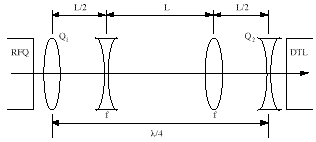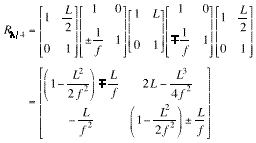The issue involved in the simultaneous matching
of H+ and H- beams between an RFQ and DTL lies in the fact that
both beams experience the same electric-field forces at a given
position in the RFQ. Hence, the two beams are focused to the same
correlation. However, matching to a DTL requires correlation of
the opposite sign. The Brown-Servranckx [1] quarter-wave (![]() )
matching transformer system, which requires four quadrupoles,
provides a method to simultaneously match
)
matching transformer system, which requires four quadrupoles,
provides a method to simultaneously match ![]() and
and ![]() beams between an RFQ and a DTL. The
method requires the use of a special RFQ section to obtain the
Twiss parameter conditions
beams between an RFQ and a DTL. The
method requires the use of a special RFQ section to obtain the
Twiss parameter conditions ![]() and
and ![]() at the exit of the RFQ [2]. This matching between the RFQ and
DTL is described below.
at the exit of the RFQ [2]. This matching between the RFQ and
DTL is described below.
Figure 1 shows the two-quadrupole-![]() matching transformer with an additional quadrupole placed at each
end to produce the appropriate Twiss parameters to match to the
FODO lattice of the downstream DTL. This 4-quadrupole transport
section will transform a beam with Twiss parameters
matching transformer with an additional quadrupole placed at each
end to produce the appropriate Twiss parameters to match to the
FODO lattice of the downstream DTL. This 4-quadrupole transport
section will transform a beam with Twiss parameters ![]() and
and ![]() to a beam having Twiss parameters
to a beam having Twiss parameters ![]() and
and ![]() . The middle two focusing elements
plus the three drift lengths comprise the
. The middle two focusing elements
plus the three drift lengths comprise the ![]() -
(quarter wave) transport. Quadrupole Q1, placed where
-
(quarter wave) transport. Quadrupole Q1, placed where ![]() and
and ![]() , adjusts
, adjusts ![]() while
preserving the condition
while
preserving the condition ![]() and is used to
adjust the beam size at Q2 while the quarter wave transformer
preserves the condition
and is used to
adjust the beam size at Q2 while the quarter wave transformer
preserves the condition ![]() and
and ![]() .
Quadrupole Q2 is used to obtain the final desired
.
Quadrupole Q2 is used to obtain the final desired ![]() while again preserving the condition
while again preserving the condition ![]() .
Because of the time varying nature of the RFQ, the
.
Because of the time varying nature of the RFQ, the ![]() and
and ![]() beams have the relationship
beams have the relationship ![]() ,
and
,
and ![]() at the exit of the RFQ; but, in a
dc quadrupole channel, the matched beam satisfies
at the exit of the RFQ; but, in a
dc quadrupole channel, the matched beam satisfies ![]() and
and ![]() . By setting
. By setting ![]() ,
for both
,
for both ![]() and
and ![]() at
the end of the RFQ, the Brown-Servranckx [1] matching transformer
can be used for matching.
at
the end of the RFQ, the Brown-Servranckx [1] matching transformer
can be used for matching.

The quarter-wave transport matrix, ![]() ,
is (the sign of the focal length depends on the charge of the
hydrogen ion)
,
is (the sign of the focal length depends on the charge of the
hydrogen ion)
 (1)
(1)
which, in terms of the phase advance per period,
m, and the
Twiss parameters, is
 . (2)
. (2)
Equation (2) for the quarter wave transport system
is
 (2a)
(2a)
where m
= 90o. This condition is achieved in Eq. (1) when
![]() (3)
(3)
which determines the focal length, f, of the
inner two quadrupole lenses given the lens separation, L.
We require a transport matrix that preserves the condition ![]() .
The Twiss parameter map for any matrix R is
.
The Twiss parameter map for any matrix R is
 . (4)
. (4)
The matrix elements in parenthesis change sign in
going from the x-plane to the y-plane. The other elements do not
change sign. For ![]() and
and ![]() ,
then
,
then ![]() and
and ![]() . This
is achievable with the quarter-wave transport system because the
diagonal matrix elements
. This
is achievable with the quarter-wave transport system because the
diagonal matrix elements ![]() and
and ![]() change signs between the x- and y-planes while the
off-diagonal matrix elements
change signs between the x- and y-planes while the
off-diagonal matrix elements ![]() and
and ![]() do not change. The quadrupole lenses placed at the beginning and
end of the quarter-wave transport preserve the condition
do not change. The quadrupole lenses placed at the beginning and
end of the quarter-wave transport preserve the condition ![]() .
The transport matrix elements for a single lens,
.
The transport matrix elements for a single lens,
 , (5)
, (5)
when substituted in Eq. (4), gives
 . (6)
. (6)
When ![]() and
and ![]() ,
then
,
then ![]() and
and ![]() .
.
The Brown-Servranckx transport system is straight
forward to tune. Given a circular beam at the location of quadrupole
Q1 in Fig. 1, the focal length of the middle two quadruples is
adjusted to produce a circular beam at the location of quadruple
Q2 giving a quarter wave transport between Q1 and Q2. Quadrupole
Q1 is then adjusted to give the proper beam size at the location
of Q2 (giving ![]() ). Finally, quadrupole Q2
is adjusted so that the beam size is a constant after each FODO
cell of the DTL (giving the correct
). Finally, quadrupole Q2
is adjusted so that the beam size is a constant after each FODO
cell of the DTL (giving the correct ![]() ).
There are limitations to the degree of magnification that can
be achieved by this transformer. The Twiss parameter
).
There are limitations to the degree of magnification that can
be achieved by this transformer. The Twiss parameter ![]() has a minimum value equal to
has a minimum value equal to ![]() . For details
of this and other useful insights to beam transport, see Ref.
1. If the transverse focusing per unit length is identical at
the output of the RFQ and the input of the DTL, the quarter-wave
transport can be eliminated. Also, if in addition to the above
condition,
. For details
of this and other useful insights to beam transport, see Ref.
1. If the transverse focusing per unit length is identical at
the output of the RFQ and the input of the DTL, the quarter-wave
transport can be eliminated. Also, if in addition to the above
condition, ![]() at the RFQ output, a single
magnetic quadrupole can be used to obtain the appropriate matching
(
at the RFQ output, a single
magnetic quadrupole can be used to obtain the appropriate matching
(![]() ) of both
) of both ![]() and
and
![]() beams into the DTL.
beams into the DTL.
[1] K. L. Brown and R. V. Servranckx, "First- and Second-Order Charged Particle Optics," SLAC-PUB-3381, July 1984.[2] K. Crandall, "Ending the RFQ Vane Tips with Quadrupole Symmetry," 1994 Linac Conference, Tsukuba, Japan.
*Work supported by the U.S. Department of Energy